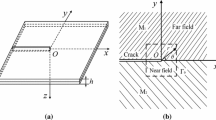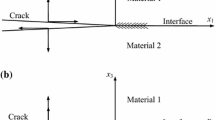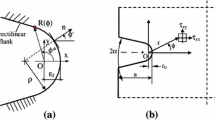Abstract
The problem of a notch at a bimaterial interface is considered. An influence function is developed for determining the stress intensity factors for all notch angles in infinite bodies. Particular solutions are obtained for cracks in homogeneous and bimaterial bodies and for bonded strips. Comparison with solutions in the literature is excellent.
Similar content being viewed by others
References
Belov, A.Yu. and Kirchner, H.O.K. (1995). Higher order weight functions in fracture mechanics of inhomogeneous anisotropic solids. Philosophical Magazine A 72, 1471–1483.
Belov, A.Yu. and Kirchner, H.O.K. (1996). Universal weight functions for elastically anisotropic, angularly inhomogeneous media with notches and cracks. Philosophical Magazine A 73, 1621–1646.
Bogy, D.B. (1971). Two edge-bonded elastic wedges of different materials and wedge angles under surface tractions. Journal of Applied Mechanics 38, 377–386.
Dundurs, J. (1969). Edge-bonded dissimilar orthogonal elastic wedges under normal and shear loading. Journal of Applied Mechanics 36, 650–652.
Hein, V.L. and Erdogan, F. (1971). Stress singularities in a two-material wedge. International Journal of Fracture Mechanics 7, 317–330.
Munz, D. and Yang, Y.Y. (1992). Stress singularities at the interface in bonded dissimilar materials under mechanical and thermal loading. Journal of Applied Mechanics 59, 857–861.
Munz, D. and Yang, Y.Y. (1994). Stresses near the free edge of the interface in ceramic-to-metal joints. Journal of the European Ceramic Society 13, 453–460.
Rice, J.R. (1988). Elastic fracture mechanics concepts for interfacial cracks. Journal of Applied Mechanics 55, 98–103.
Rice, J.R. and Sih, G.C. (1965). Plane problems of cracks in dissimilar media. Journal of Applied Mechanics 32, 418–423.
Sham, T.-L. and Bueckner, H.F. (1988). The weight-function theory for piecewise homogeneous isotropic notches in antiplane strain. Journal of Applied Mechanics 55, 596–603.
Tada, H., Paris, P. and Irwin, G. (1985). The Stress Analysis of Cracks Handbook, Paris Productions, Inc., Missouri, USA. 3.6.
Tilscher, M., Munz, D. and Yang, Y.Y. (1994). The relationship between the stress intensity factor and the stress exponent for bimaterials under thermal loading. International Journal of Fracture 65, R23–R28.
Timoshenko, S.P. and Goodier, J.N. (1970). Theory of Elasticity, Third Edition, McGraw-Hill, New York.
Author information
Authors and Affiliations
Rights and permissions
About this article
Cite this article
Banks-Sills, L., Yang, Y.Y. & Munz, D. An influence function for stress intensity factors of bimaterial notched bodies. International Journal of Fracture 85, 333–350 (1997). https://doi.org/10.1023/A:1007413332084
Issue Date:
DOI: https://doi.org/10.1023/A:1007413332084




